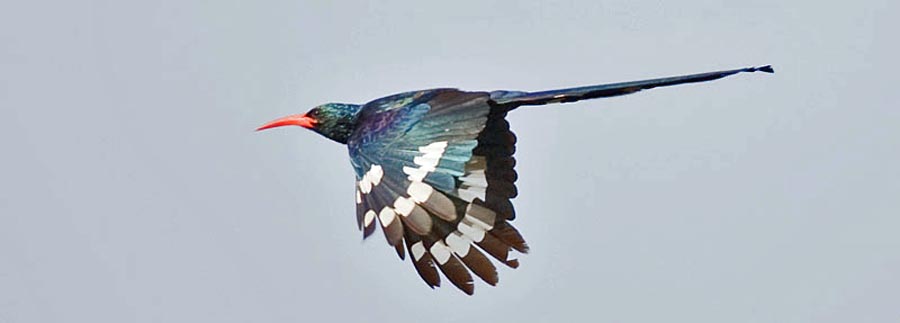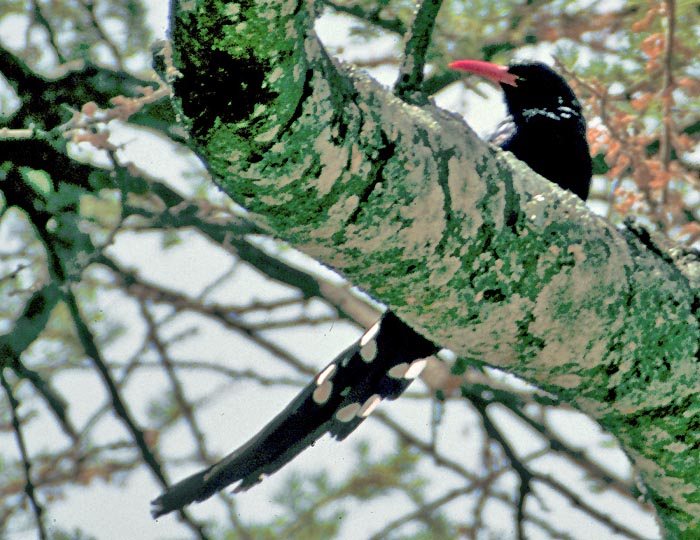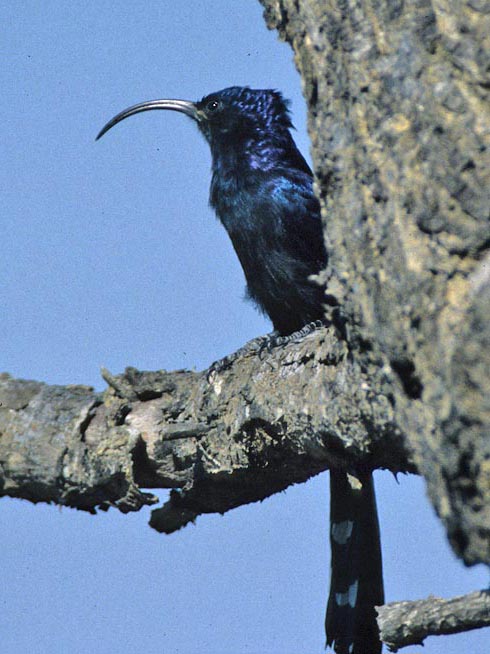
a web page by Don Roberson |
WOODHOOPOES & SCIMITARBILLS Phoeniculidae |
 |
|
Since the DNA-DNA hybridization studies of Sibley & Ahlquist (1990), the members of the Phoeniculidae have been placed in just two genera: Phoeniculus for 5 species of woodhoopoes, and Rhinopomastus for 3 species of scimitarbills. Certainly the most widespread and well-known species in the family is Green Woodhoopoe (left and above, the nice flight shot is by Arthur Grosset). They occur over a wide range of open woodland, from thornbrush or savanna to riparian woodlands and gardens, all of which have trees large enough to hold cavities for roosting and nesting. |
Members of the Phoeniculidae are primarily resident species, living in small flocks and extended family groups, and foraging on the limbs and trunks of trees. Most nests have been in natural cavities in large trees but some species also use old nest-holes created by woodpeckers or barbets. Their long bills – that vary in length, shape, and color among the species — permit them to forage for insects, spiders, and the like in places otherwise unreachable by other birds, in foliage and flowers. All species in the family have long and powerful tails, and strong legs and feet, with sharp claws, that aid in moving about the canopy of tall trees. |
Black Scimitarbill R. aterrimus, often called "Black Woodhoopoe" in earlier literature, has a much straighter bill and was sometimes placed in its own genus (Scoptelus), but molecular studies placed it with the other scimitarbills (e.g., Sibley & Ahlquist 1990). In an early DNA hybridization analysis (Sibley & Ahlquist 1986), the three scimitarbills were even placed in their own family! More recently, many separate scimitarbills from woodhoopoes at the subfamily level (Ligon 2001). Two slender and dark species of wood-hoopoe — the small Forest Woodhoopoe P. castaneiceps and larger White-headed Woodhoopoe P. bollei — are patchily distributed in lowland and montane forests near the equator from west Africa to east Africa. Although locally common in some areas, the distribution is fragmented and they can often be rare. Fry et al. (1988) describe a communal bowing display in White-headed Woodhoopoe in which "birds perch close together on branch, sway bodies back and forth, and raise depress tails." Black-billed Woodhoopoe P. somaliensis is a bird of dry thornscrub and riparian forests from Ethiopia to northeast Kenya (and is the only one of the 8 current species I haven't seen). But Violet Woodhoopoe P. damarensis has two widely separated ranges: nominate race in Namibia and Angola and race granti in s. Ethiopia and Kenya. These two populations could well represent different species but Ligon (2001) recommends awaiting further molecular review to determine whether Violet Woodhoopoe itself is worthy of species rank; it could be just a variant of Green Woodhoopoe. Green and Violet Woodhoopoes differ primarily in iridescent sheen. A metallic sheen to body feathers is characteristic of many species in this family, and can be seen in the photos here. Finally, all species in this family produce a malodorous clear oil from uropygial gland, said to be "less pungently odorous" in scimitarbills than woodhoopoes (Fry et al. 1988). Could this be an opportunity to learn to bird by smell? ! |
Photos: The perched Green Woodhoopoe Phoeniculus purpureus was in Tarangire NP, Tanzania, in Aug 2002; Arthur Grosset photographed the flying Green Woodhoopoe in Ghana. The Common Scimitarbill Rhinopomastus cyanomelas was in Kruger NP, South Africa, in July 1996. Photos © Don Roberson and © Arthur Grosset, as credited and used with permission; all rights reserved. Arthur Grosset has a fine website with many photos of tropical birds. Bibliographic note: There is no "family book" for this small family, but the entire set is well-covered in the Handbook of the Birds of the World series (Ligon 2001). Literature cited:
|
 The
woodhoopoes are a small and ancient lineage of medium-sized, arboreal
non-passerines that inhabit sub-Saharan Africa. This was not always the
case, as phoeniculid-like fossils have been recovered in central
Europe. Something happening in the distant past that has made then a
relict family endemic to Africa (Ligon 2001).
The
woodhoopoes are a small and ancient lineage of medium-sized, arboreal
non-passerines that inhabit sub-Saharan Africa. This was not always the
case, as phoeniculid-like fossils have been recovered in central
Europe. Something happening in the distant past that has made then a
relict family endemic to Africa (Ligon 2001).  Two
of the three species of scimitarbills have particularly long and
decurved bills — black in Common Scimitarbill and red in Abyssinian
Scimitarbill R. minor. The Common Scimitarbill
(right) has an impressive decurved bill. It is capable of moving down
tree trunks with the head pointed downwards, using the long tail as a
brace (Ligon 2001).
Two
of the three species of scimitarbills have particularly long and
decurved bills — black in Common Scimitarbill and red in Abyssinian
Scimitarbill R. minor. The Common Scimitarbill
(right) has an impressive decurved bill. It is capable of moving down
tree trunks with the head pointed downwards, using the long tail as a
brace (Ligon 2001).